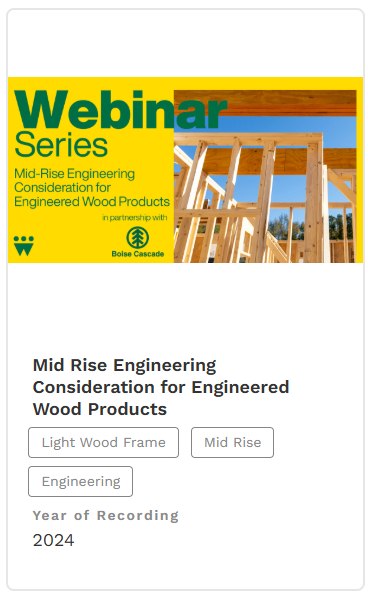Read more

Read more

Read more

Read more

Read more

Read more

Read more
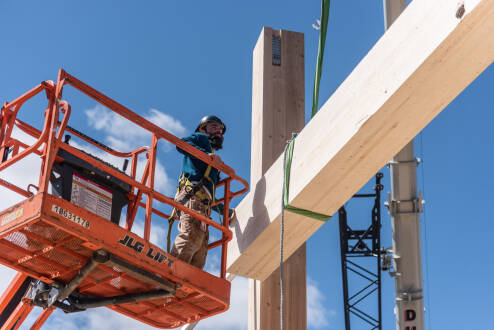
Read more
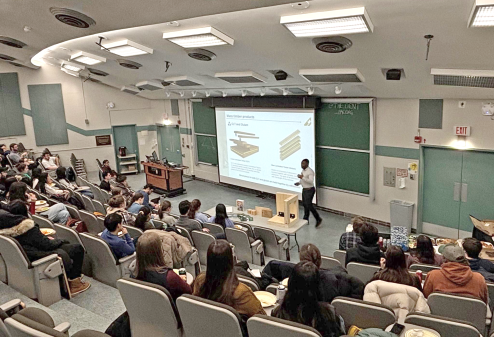
Widespread adoption depends on ease of use. That’s why CWC is focused on equipping practitioners, educators, and industry partners with practical tools, trusted information, and ongoing support. From design guides and software to training programs and helpdesk services, we are working to simplify wood construction at every stage. We’re also growing our network, expanding educational offerings, and investing in digital innovation to ensure that wood remains an accessible, adaptable solution in an evolving construction landscape.

Top of Section
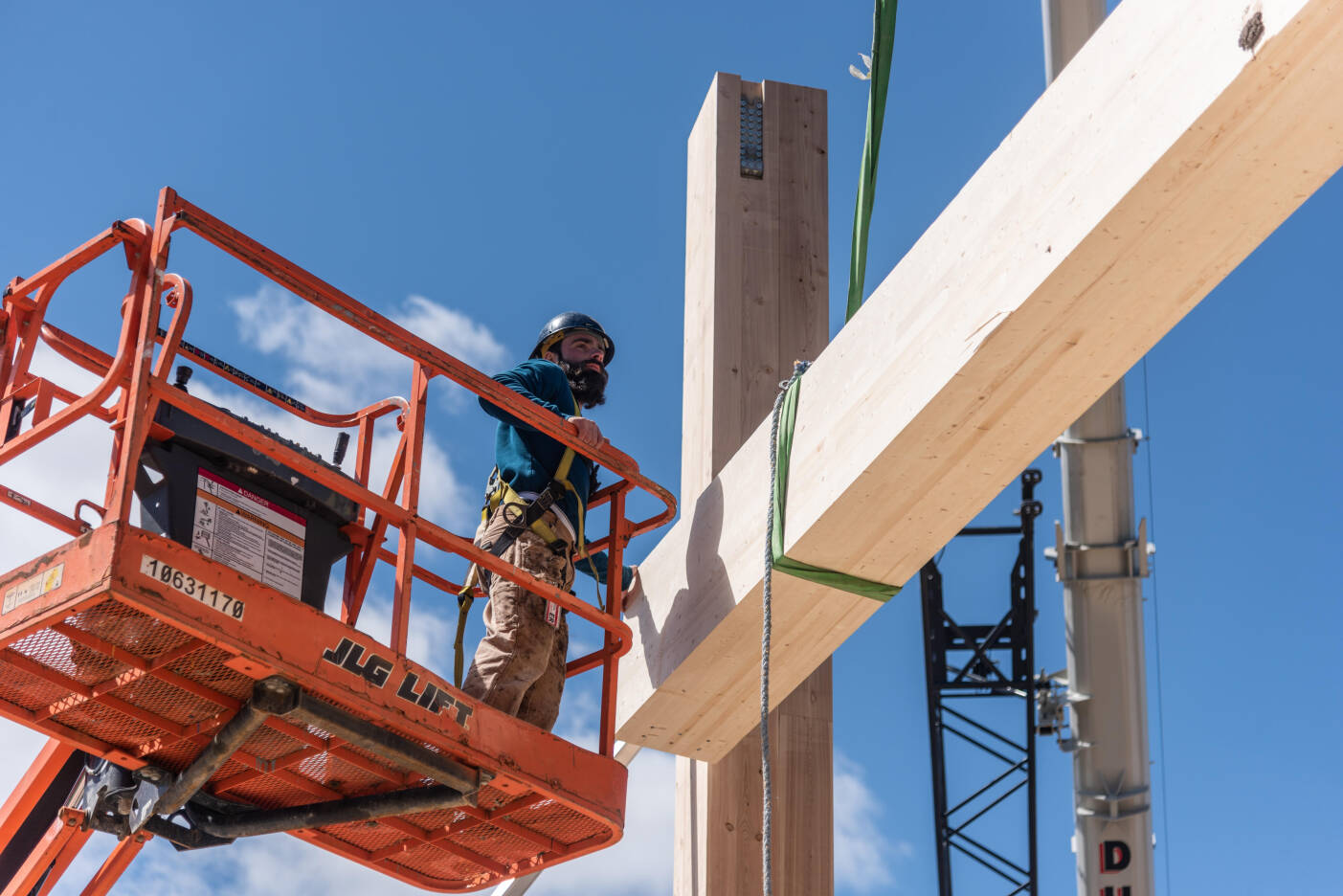
Throughout 2024 CWC WoodWorks programs offered up 3542 technical support interactions to 4001 contacts, which were linked to the support of 499 projects at various stages of construction. This 53% increase of technical support interactions has aligned with our focus on increasing project support.
Directly related to the diversified skill set of the Technical Advisor teams, these interactions ranged from detailed technical analysis, referrals and relationship building, education of different wood systems and how they can be used and general encouragement to ensure wood construction is the first choice.
These efforts led to 298 projects moving to the construction stage, accounting for over 271 Million board feet of incremental volume, a slight +1% increase over last year despite challenging market conditions, particularly around financing rates. Supported projects were 70% light wood frame and 30% mass timber systems.

Top of Section

Significant strides have been made when focusing on Advancing Wood Education in Canada Program. The formation of an agile and engaged Education Advisory Committee was a highlight of 2024. The Committee, with members from academia, industry and design has met twice. The valued insight from this committee has already allowed us to shift our strategic focus to the development of curricula for elective courses as a new focus for impact. Further to this the launch of the Timber Engineering Chapter for University Students in Ottawa is a major highlight.
We have developed several eLearning modules for consumption and have begun the development of an introductory Wood Course for University level students. Other curriculum support initiatives also gained traction, with CWC contributing to the SAIT Mass Timber Microcertificate and Project Learning Tree Canada's high school wood construction course. Small-scale mass timber mockups were developed and distributed to help students better understand modern building systems.
Support of two student competitions allowed the education team to engage fully with students and offer mentoring and support. Several guest lectures to students were engaged throughout 2024 with regional support from Market Development staff to ensure efficiency and impact.
The Catherine Lalonde Memorial Scholarship received 28 applications from graduate students representing 12 Canadian universities. The research projects covered a broad spectrum, including architecture, wood sciences, and structural and timber engineering. Two scholarships were awarded.
The recipients were: Laura Walters (McMaster University, University of Northern British Columbia) and Jiawen Shen (University of British Columbia. Both winners exemplify the transformative potential of wood-related research in advancing sustainability and innovation in the built environment.
2024 marked a historic milestone for the Catherine Lalonde Memorial Scholarship program as, for the first time, it was awarded to two exceptional women. Their achievements highlight the outstanding talent driving innovation in wood research and construction. We are inspired by their contributions and the growing diversity shaping the future of wood-based solutions.

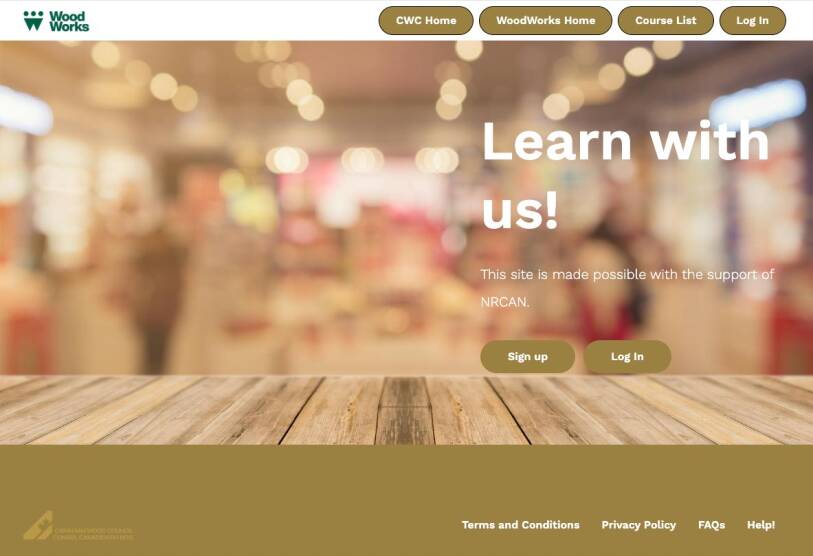
Top of Section
The CWC eLearning Centre experienced steady growth in both content and user engagement throughout 2024–2025. A total of 12 new courses were added over the year, alongside significant upgrades to 22 existing courses to include quizzes, allowing them to qualify as structured learning for practicing architects. This enhancement broadened the platform’s appeal and utility as a professional development resource.
User engagement remained strong, with 619 new accounts created and 1,366 continuing education hours delivered through the same number of courses viewed. A notable spike in activity occurred in Q2, coinciding with the end of the continuing education cycle for many architects, reinforcing the platform’s relevance and value in meeting regulatory requirements.
In 2024, planning began for an important evolution of the platform. Leveraging the Digital Resource Hub’s back end, a new learning management system was being developed to support micro-credentialing, modular course pathways, and improved user experience through tiered access. The upgraded system would allow for seamless migration of current accounts while significantly expanding future capabilities.
Overall, the eLearning Centre continues to support CWC’s mandate for knowledge transfer, offering scalable, accessible education to a growing and diversified professional audience.
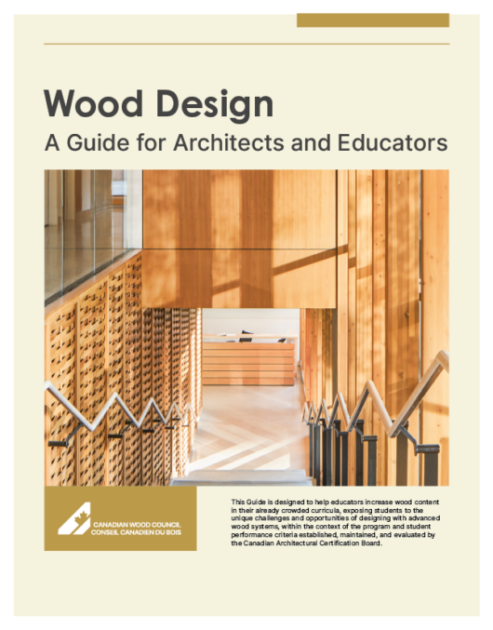

Top of Section
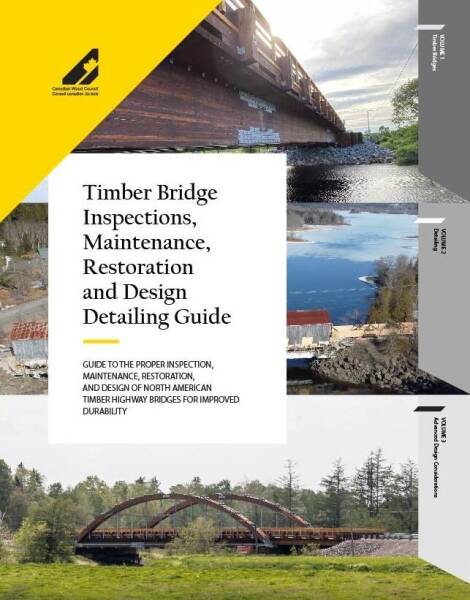

This year, the Canadian Wood Council released the Alternative Solutions Guide, a practical resource for practitioners exploring innovative pathways to code compliance. While alternative solutions have been part of the National Building Code since 2005, they remain underutilized due to limited awareness. The guide addresses this gap by outlining how to evaluate and apply alternative solutions, particularly in mass timber construction. With increased innovation in building materials and techniques, and broader access to performance testing tools, this guide supports a growing need for flexibility in design approaches that are not explicitly covered in prescriptive code provisions.
Wood Design: A Guide for Architects and Educators is a publication designed to help educators increase wood content in their curricula, exposing students to the unique challenges and opportunities of designing with advanced wood systems, within the context of the program and student performance criteria established, maintained, and evaluated by the Canadian Architectural Certification Board. (The development and publishing costs of this publication generously supported by NRCan)
Timber Bridge Inspection, Maintenance, Restoration and Design Detailing Guide is a comprehensive, 3-volume guide on timber bridge inspection, maintenance, restoration, and detailing covers everything you need to know about detailing durable wood bridges, starting with a thorough description of wood’s unique and often advantageous properties, and concluding with advanced topics that will be of interest to engineers world-wide. (The development and publishing costs of this publication generously supported by NRCan, Ontario Ministry of Natural Resources, Wood Preservation Canada, and Wood Research and Development).
CWC concluded, with industry support, the Opportunities for Light Wood Frame and Mass Timber study in 2024. This important study expanded upon internal market research opportunities to take a deeper dive into key focus areas identified as high value. The study identified barriers and opportunities to the greater adoption of wood market share in the identified areas, including low to mid rise light wood framing, mass timber mid to high residential opportunities and numerous non-residential markets such as warehouses, data centres, education buildings and the low-rise commercial market. The study, confirming CWC’s market analysis, shows potential of nearly a billion board feet of incremental opportunities for CWC to pursue.
WoodWorks® Software continues to be a valuable tool for engineers, designers, code officials, and educators in both Canada and the US. In 2024, the total licenses sold was almost double our goal for the year. This business centre generated over $860,000 in sales from 4,834 subscriptions sold. The software modules (Sizer, Shearwalls, and Connections) help simplify wood design, enabling more engineers and architects to specify wood confidently, which ultimately leads to more wood construction in the built environment.
Top of Section

In partnership with George Brown College’s Brookfield Sustainability Institute, the 2024 WoodWorks Summit was introduced as a strategic evolution of CWC’s Wood Solutions Conference. The Summit emphasized policy and development themes aimed at catalyzing regulatory and market opportunities for wood construction. The event, held at George Brown’s waterfront campus in Toronto, featured panel discussions, site tours, an industry showcase, and networking events. A new collaboration with the Urban Land Institute helped attract developer audiences, with their fall networking event integrated into the program.
Ministerial participation, including opening remarks by Ontario’s Associate Minister of Forestry and a major code change announcement by the Minister of Municipal Affairs and Housing, elevated the event’s profile. Robust ticket sales and a sold-out exhibitor showcase reflected strong industry engagement, with 2,214 continuing education hours delivered.
Final survey data confirmed the event’s impact: 57% of attendees were new to WoodWorks events, and 100% expressed interest in future participation. All respondents rated the content as relevant and the event organization as good or excellent. Notably, 86% said they were more likely to use or specify wood, and 93% had already shared insights from the Summit—affirming its success as a transformative industry platform.
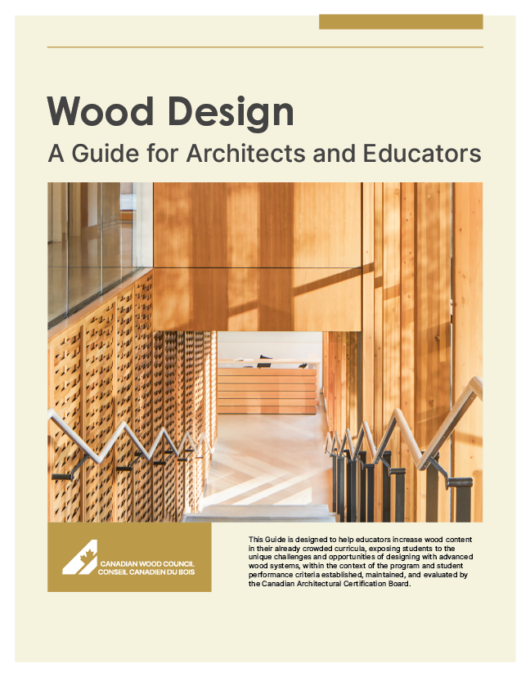
Top of Section

The Wood Solutions Conference series continues to demonstrate strong national engagement and program delivery. In 2024, four regional conferences—including Les Conférences Cecobois in Québec—successfully met attendance and exhibitor targets, with educational content receiving strong reviews. A notable shift in attendee profiles was observed, with engineers comprising 45% of the audience in Ontario and nearly 60% in Calgary, underscoring the program’s resonance with project-focused professionals.
Early 2025 saw further innovation and regional adaptation. In Ottawa, the event was hosted for the first time at the National Arts Centre, with its wood-accented architecture enhancing the experience. The program featured 14 speakers, including international keynote Nicolas Ziesel, and delivered over 1,000 continuing education hours. A bilingual stream was introduced and well attended, confirming its importance in this market.
In Edmonton, the 2025 Alberta conference drew 253 professionals and delivered 1,518 continuing education hours. A newly added evening reception attracted over 50 attendees, enhancing networking opportunities. Participant data indicated that 34 attendees were actively seeking support for current projects, a strong outcome reflecting market relevance.
These conferences continue to serve as effective platforms for technical learning, networking, and expanding wood’s presence in building design and construction across Canada, while also delivering strong value to WoodWorks corporate partners by facilitating meaningful connections with industry practitioners.
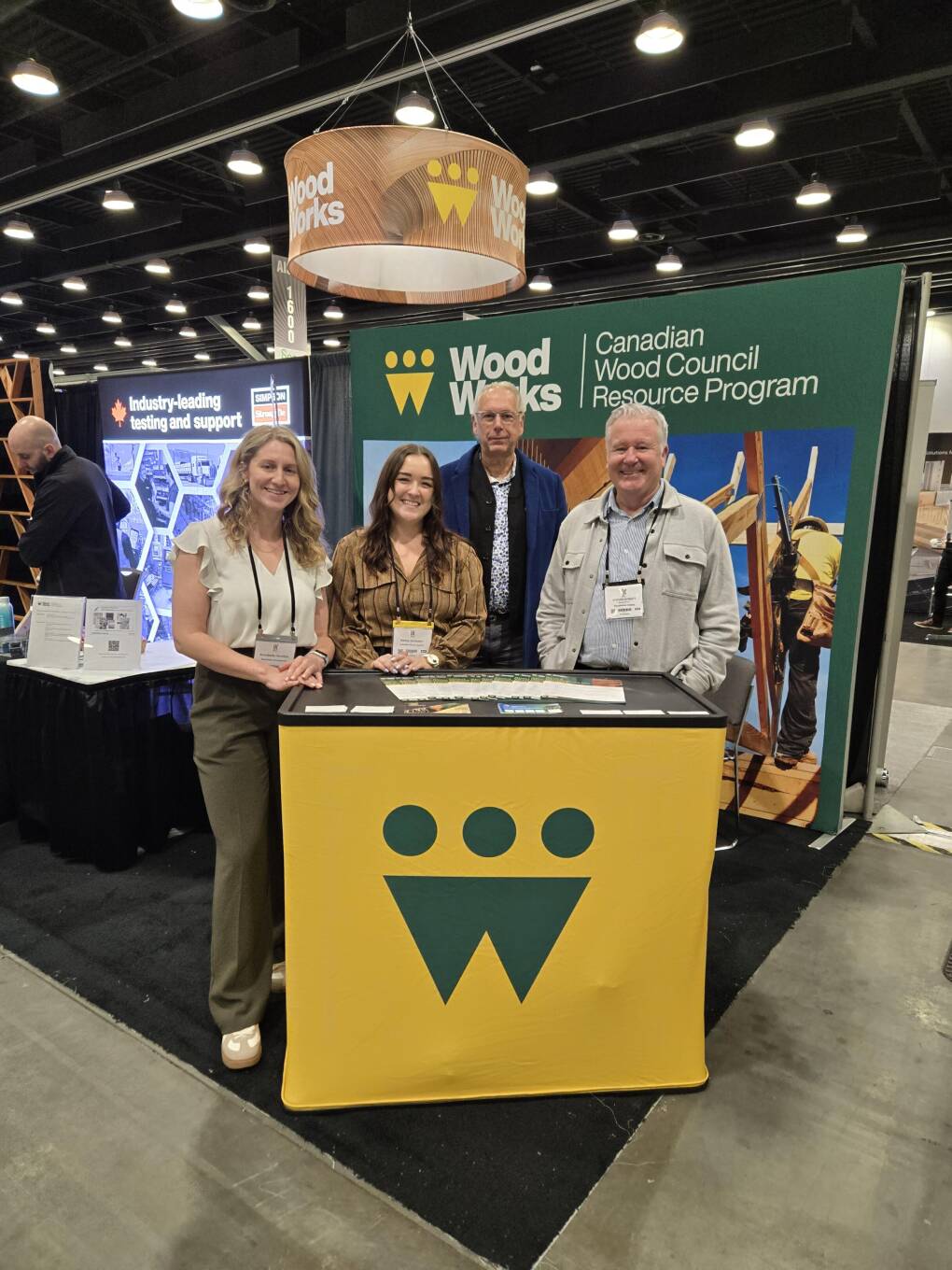
In February 2025, WoodWorks BC successfully launched the inaugural WoodWorks @ BuildEx Conference in collaboration with Informa, marking a key milestone in expanding industry reach and impact. The event attracted over 704 unique participants, 57% of whom were new to the WoodWorks network. Attendees included architects (27%), developers (11%), general contractors (11%), and engineers (9%), underscoring the program’s ability to engage priority industry stakeholders.
WoodWorks contributed 14 educational sessions, representing 20% of the total conference programming, and featured 31 wood product exhibitors—further reinforcing wood’s presence in front of a 8,000+ construction professional audience.
The success of WoodWorks @ BuildEx strengthened brand visibility and solidified WoodWorks’ leadership in the wood construction space.
Top of Section

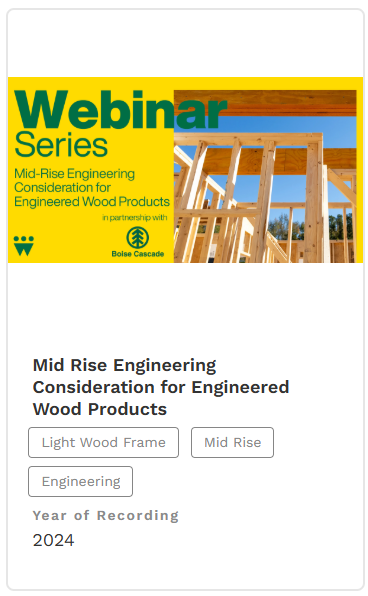
The WoodWorks webinar series experienced strong growth in both attendance and impact in 2024, emerging as a cornerstone of our national technology transfer and communications strategy. Over the reporting period, we delivered 18 webinars to 2920 Participants, with average attendance at 162 per webinar. Removing small targeted firm based webinars, open for registration webinars averaged 287 participants per webinar.. The diversity and quality of content contributed to continued high demand, with 19% of attendees being new contacts, expanding our reach and influence across the sector.
Topics ranged from fire performance and code evolution to innovative design case studies and acoustics, with highlights including Mass Timber Fire Performance, KF Aerospace Centre for Excellence, and Designing with Shearwalls. Each webinar is delivered in partnership with a WoodWorks corporate sponsor, allowing subject matter alignment and direct post-event engagement with attendees.
The webinar platform continues to be an effective channel for knowledge exchange and meaningful partner activation.
Top of Section

Read more

Read more

Read more

Read more

Read more

Read more

Read more

Read more

Widespread adoption depends on ease of use. That’s why CWC is focused on equipping practitioners, educators, and industry partners with practical tools, trusted information, and ongoing support. From design guides and software to training programs and helpdesk services, we are working to simplify wood construction at every stage. We’re also growing our network, expanding educational offerings, and investing in digital innovation to ensure that wood remains an accessible, adaptable solution in an evolving construction landscape.


Throughout 2024 CWC WoodWorks programs offered up 3542 technical support interactions to 4001 contacts, which were linked to the support of 499 projects at various stages of construction. This 53% increase of technical support interactions has aligned with our focus on increasing project support.
Directly related to the diversified skill set of the Technical Advisor teams, these interactions ranged from detailed technical analysis, referrals and relationship building, education of different wood systems and how they can be used and general encouragement to ensure wood construction is the first choice.
These efforts led to 298 projects moving to the construction stage, accounting for over 271 Million board feet of incremental volume, a slight +1% increase over last year despite challenging market conditions, particularly around financing rates. Supported projects were 70% light wood frame and 30% mass timber systems.


Significant strides have been made when focusing on Advancing Wood Education in Canada Program. The formation of an agile and engaged Education Advisory Committee was a highlight of 2024. The Committee, with members from academia, industry and design has met twice. The valued insight from this committee has already allowed us to shift our strategic focus to the development of curricula for elective courses as a new focus for impact. Further to this the launch of the Timber Engineering Chapter for University Students in Ottawa is a major highlight.
We have developed several eLearning modules for consumption and have begun the development of an introductory Wood Course for University level students. Other curriculum support initiatives also gained traction, with CWC contributing to the SAIT Mass Timber Microcertificate and Project Learning Tree Canada's high school wood construction course. Small-scale mass timber mockups were developed and distributed to help students better understand modern building systems.
Support of two student competitions allowed the education team to engage fully with students and offer mentoring and support. Several guest lectures to students were engaged throughout 2024 with regional support from Market Development staff to ensure efficiency and impact.
The Catherine Lalonde Memorial Scholarship received 28 applications from graduate students representing 12 Canadian universities. The research projects covered a broad spectrum, including architecture, wood sciences, and structural and timber engineering. Two scholarships were awarded.
The recipients were: Laura Walters (McMaster University, University of Northern British Columbia) and Jiawen Shen (University of British Columbia. Both winners exemplify the transformative potential of wood-related research in advancing sustainability and innovation in the built environment.
2024 marked a historic milestone for the Catherine Lalonde Memorial Scholarship program as, for the first time, it was awarded to two exceptional women. Their achievements highlight the outstanding talent driving innovation in wood research and construction. We are inspired by their contributions and the growing diversity shaping the future of wood-based solutions.
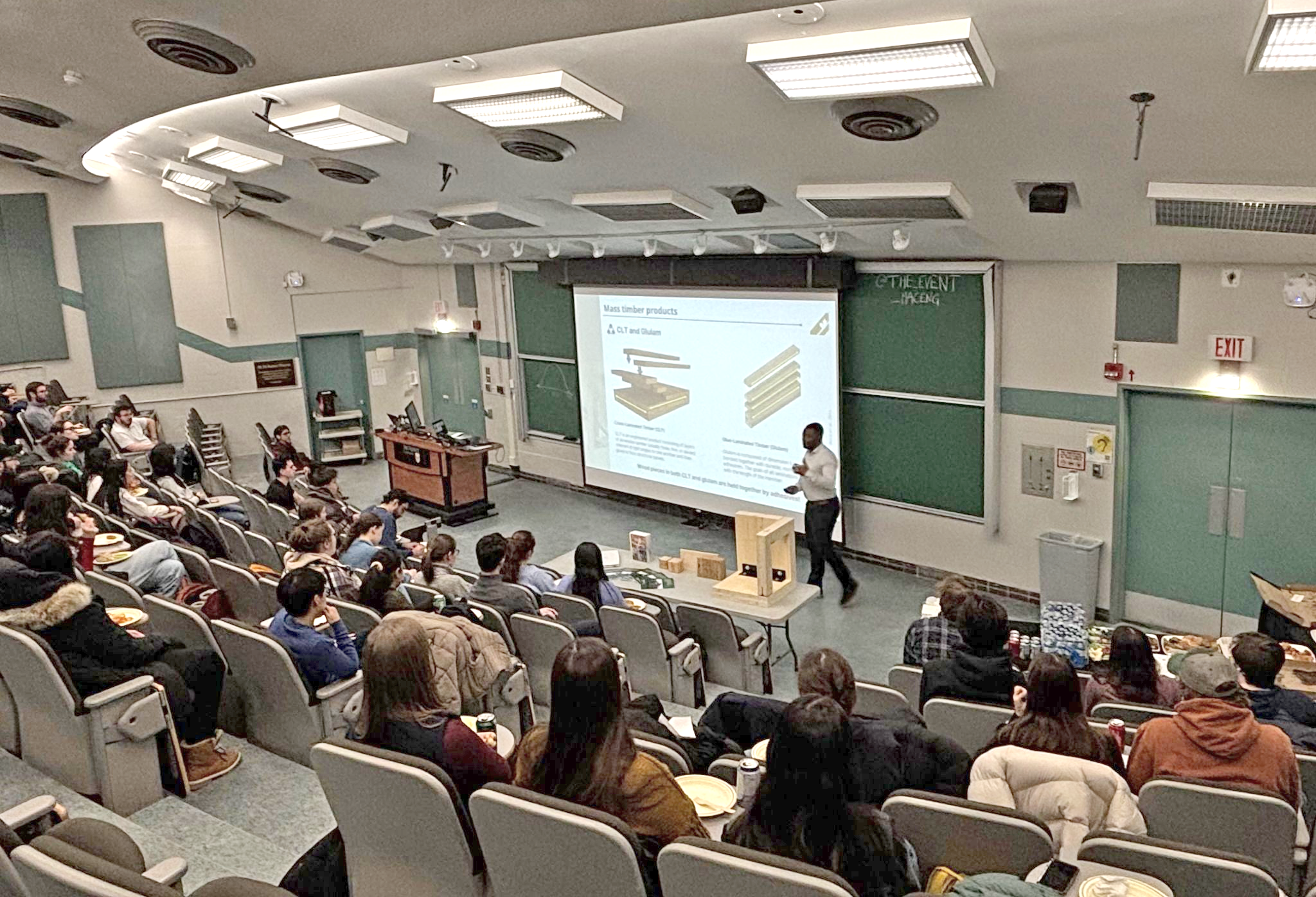
The CWC eLearning Centre experienced steady growth in both content and user engagement throughout 2024–2025. A total of 12 new courses were added over the year, alongside significant upgrades to 22 existing courses to include quizzes, allowing them to qualify as structured learning for practicing architects. This enhancement broadened the platform’s appeal and utility as a professional development resource.
User engagement remained strong, with 619 new accounts created and 1,366 continuing education hours delivered through the same number of courses viewed. A notable spike in activity occurred in Q2, coinciding with the end of the continuing education cycle for many architects, reinforcing the platform’s relevance and value in meeting regulatory requirements.
In 2024, planning began for an important evolution of the platform. Leveraging the Digital Resource Hub’s back end, a new learning management system was being developed to support micro-credentialing, modular course pathways, and improved user experience through tiered access. The upgraded system would allow for seamless migration of current accounts while significantly expanding future capabilities.
Overall, the eLearning Centre continues to support CWC’s mandate for knowledge transfer, offering scalable, accessible education to a growing and diversified professional audience.

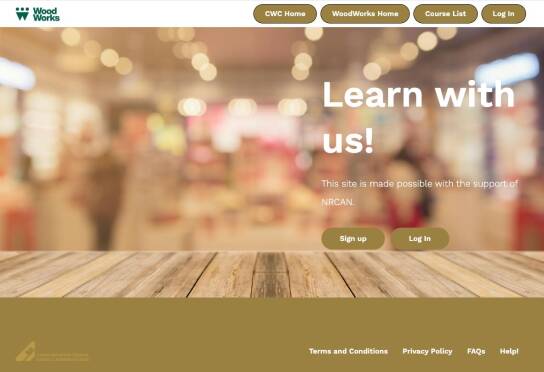
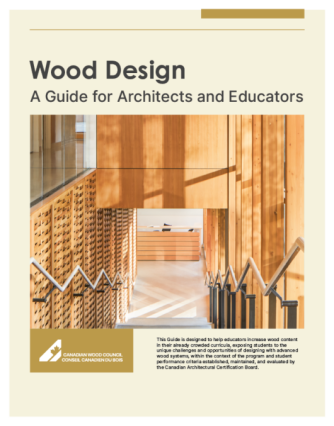
This year, the Canadian Wood Council released the Alternative Solutions Guide, a practical resource for practitioners exploring innovative pathways to code compliance. While alternative solutions have been part of the National Building Code since 2005, they remain underutilized due to limited awareness. The guide addresses this gap by outlining how to evaluate and apply alternative solutions, particularly in mass timber construction. With increased innovation in building materials and techniques, and broader access to performance testing tools, this guide supports a growing need for flexibility in design approaches that are not explicitly covered in prescriptive code provisions.
Wood Design: A Guide for Architects and Educators is a publication designed to help educators increase wood content in their curricula, exposing students to the unique challenges and opportunities of designing with advanced wood systems, within the context of the program and student performance criteria established, maintained, and evaluated by the Canadian Architectural Certification Board. (The development and publishing costs of this publication generously supported by NRCan)
Timber Bridge Inspection, Maintenance, Restoration and Design Detailing Guide is a comprehensive, 3-volume guide on timber bridge inspection, maintenance, restoration, and detailing covers everything you need to know about detailing durable wood bridges, starting with a thorough description of wood’s unique and often advantageous properties, and concluding with advanced topics that will be of interest to engineers world-wide. (The development and publishing costs of this publication generously supported by NRCan, Ontario Ministry of Natural Resources, Wood Preservation Canada, and Wood Research and Development).
CWC concluded, with industry support, the Opportunities for Light Wood Frame and Mass Timber study in 2024. This important study expanded upon internal market research opportunities to take a deeper dive into key focus areas identified as high value. The study identified barriers and opportunities to the greater adoption of wood market share in the identified areas, including low to mid rise light wood framing, mass timber mid to high residential opportunities and numerous non-residential markets such as warehouses, data centres, education buildings and the low-rise commercial market. The study, confirming CWC’s market analysis, shows potential of nearly a billion board feet of incremental opportunities for CWC to pursue.
WoodWorks® Software continues to be a valuable tool for engineers, designers, code officials, and educators in both Canada and the US. In 2024, the total licenses sold was almost double our goal for the year. This business centre generated over $860,000 in sales from 4,834 subscriptions sold. The software modules (Sizer, Shearwalls, and Connections) help simplify wood design, enabling more engineers and architects to specify wood confidently, which ultimately leads to more wood construction in the built environment.
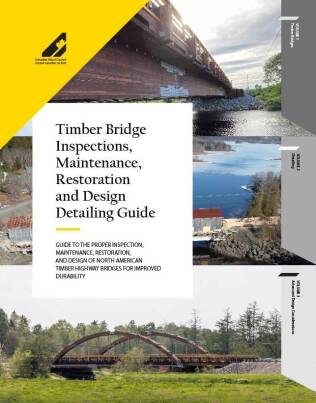


In partnership with George Brown College’s Brookfield Sustainability Institute, the 2024 WoodWorks Summit was introduced as a strategic evolution of CWC’s Wood Solutions Conference. The Summit emphasized policy and development themes aimed at catalyzing regulatory and market opportunities for wood construction. The event, held at George Brown’s waterfront campus in Toronto, featured panel discussions, site tours, an industry showcase, and networking events. A new collaboration with the Urban Land Institute helped attract developer audiences, with their fall networking event integrated into the program.
Ministerial participation, including opening remarks by Ontario’s Associate Minister of Forestry and a major code change announcement by the Minister of Municipal Affairs and Housing, elevated the event’s profile. Robust ticket sales and a sold-out exhibitor showcase reflected strong industry engagement, with 2,214 continuing education hours delivered.
Final survey data confirmed the event’s impact: 57% of attendees were new to WoodWorks events, and 100% expressed interest in future participation. All respondents rated the content as relevant and the event organization as good or excellent. Notably, 86% said they were more likely to use or specify wood, and 93% had already shared insights from the Summit—affirming its success as a transformative industry platform.

The Wood Solutions Conference series continues to demonstrate strong national engagement and program delivery. In 2024, four regional conferences—including Les Conférences Cecobois in Québec—successfully met attendance and exhibitor targets, with educational content receiving strong reviews. A notable shift in attendee profiles was observed, with engineers comprising 45% of the audience in Ontario and nearly 60% in Calgary, underscoring the program’s resonance with project-focused professionals.
Early 2025 saw further innovation and regional adaptation. In Ottawa, the event was hosted for the first time at the National Arts Centre, with its wood-accented architecture enhancing the experience. The program featured 14 speakers, including international keynote Nicolas Ziesel, and delivered over 1,000 continuing education hours. A bilingual stream was introduced and well attended, confirming its importance in this market.
In Edmonton, the 2025 Alberta conference drew 253 professionals and delivered 1,518 continuing education hours. A newly added evening reception attracted over 50 attendees, enhancing networking opportunities. Participant data indicated that 34 attendees were actively seeking support for current projects, a strong outcome reflecting market relevance.
These conferences continue to serve as effective platforms for technical learning, networking, and expanding wood’s presence in building design and construction across Canada, while also delivering strong value to WoodWorks corporate partners by facilitating meaningful connections with industry practitioners.

In February 2025, WoodWorks BC successfully launched the inaugural WoodWorks @ BuildEx Conference in collaboration with Informa, marking a key milestone in expanding industry reach and impact. The event attracted over 704 unique participants, 57% of whom were new to the WoodWorks network. Attendees included architects (27%), developers (11%), general contractors (11%), and engineers (9%), underscoring the program’s ability to engage priority industry stakeholders.
WoodWorks contributed 14 educational sessions, representing 20% of the total conference programming, and featured 31 wood product exhibitors—further reinforcing wood’s presence in front of a 8,000+ construction professional audience.
The success of WoodWorks @ BuildEx strengthened brand visibility and solidified WoodWorks’ leadership in the wood construction space.
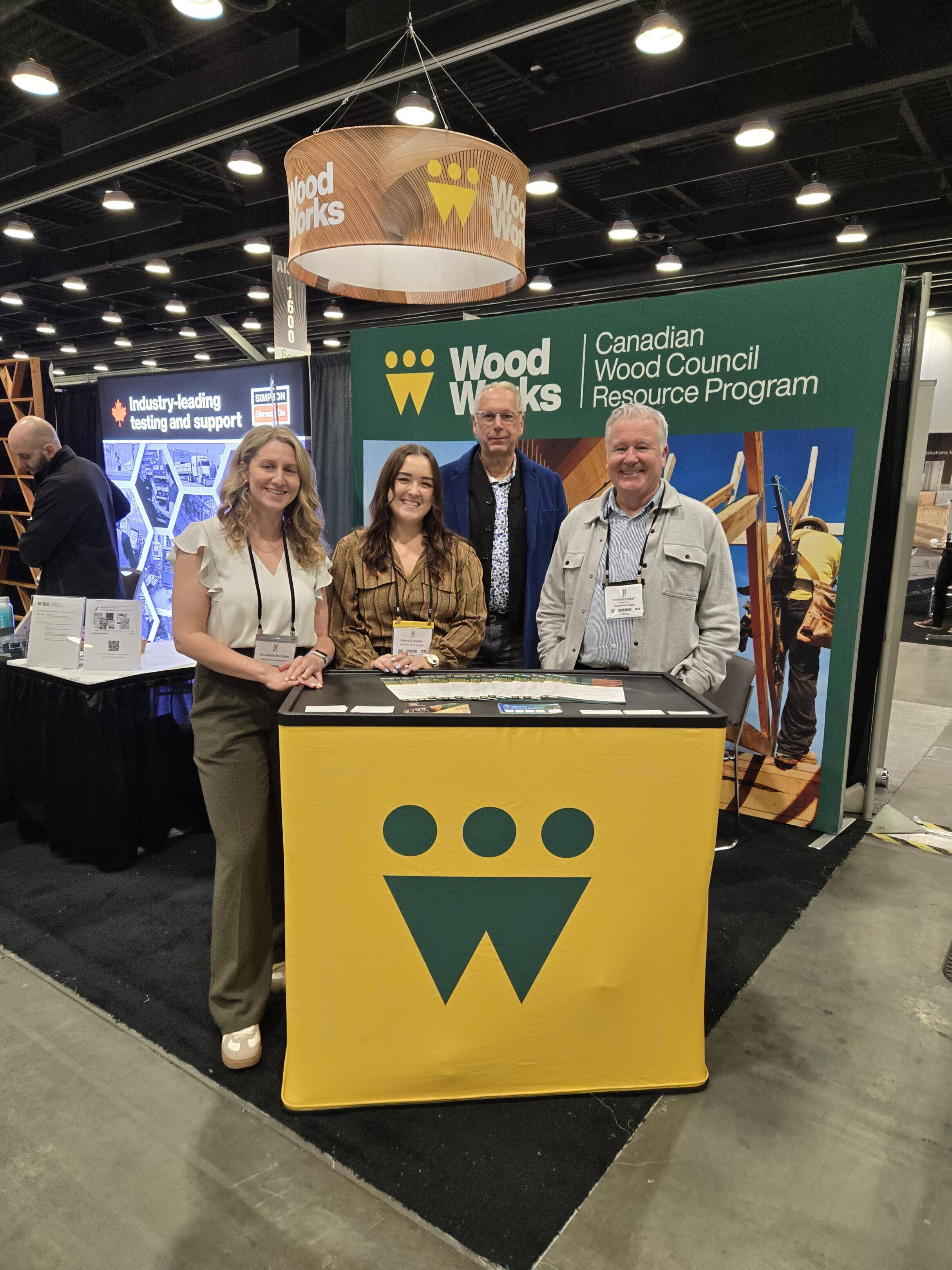
The WoodWorks webinar series experienced strong growth in both attendance and impact in 2024, emerging as a cornerstone of our national technology transfer and communications strategy. Over the reporting period, we delivered 18 webinars to 2920 Participants, with average attendance at 162 per webinar. Removing small targeted firm based webinars, open for registration webinars averaged 287 participants per webinar.. The diversity and quality of content contributed to continued high demand, with 19% of attendees being new contacts, expanding our reach and influence across the sector.
Topics ranged from fire performance and code evolution to innovative design case studies and acoustics, with highlights including Mass Timber Fire Performance, KF Aerospace Centre for Excellence, and Designing with Shearwalls. Each webinar is delivered in partnership with a WoodWorks corporate sponsor, allowing subject matter alignment and direct post-event engagement with attendees.
The webinar platform continues to be an effective channel for knowledge exchange and meaningful partner activation.
